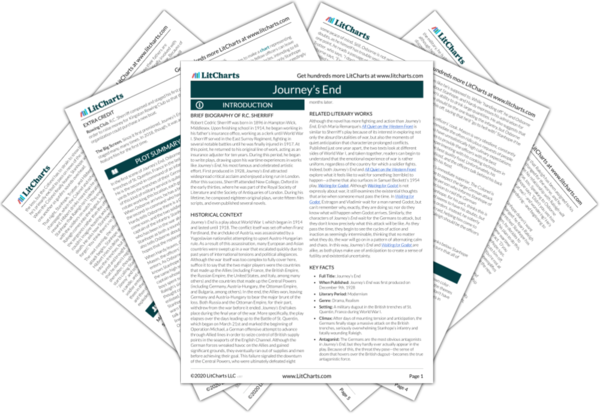Friendship and Human Interaction
In Journey’s End, R.C. Sherriff showcases the effect of war on personal relationships. In particular, he focuses on how wartime power dynamics and interpersonal attitudes alter the ways people interact with one another. This is most recognizable in Stanhope and Raleigh’s friendship, which suffers because of the various stressors of military life. For the majority of his young adult life, Raleigh has looked up to Stanhope, a classmate who eventually goes off to…
read analysis of Friendship and Human InteractionAnticipation, Expectations, and Uncertainty
Perhaps the most challenging thing the soldiers in Journey’s End face isn’t violence itself, but the threat of violence. Although their trenches are situated only 70 yards from their German enemies, the majority of their time is spent in nervous anticipation. In the long hours—and even days—between bursts of combat, the soldiers are left to grapple with their fear, which grows in intensity when the battlefront is calm. Indeed, most of Journey’s End focuses on…
read analysis of Anticipation, Expectations, and UncertaintyFear and Coping
All of the soldiers in Journey’s End find different ways to cope with their fear. In fact, their responses to fear can be broken into three categories: acceptance, denial, and evasion. In general, the most emotionally stable characters are those who accept their situation. These are people like Osborne and Raleigh, who acknowledge their own fear and unfortunate circumstances, but still bravely carry out their soldierly duties. Stanhope, on the other hand, tries…
read analysis of Fear and Coping
Repetition, Futility, and Perspective
In Journey’s End, Sherriff presents to the audience the cyclical nature of life during war. The soldiers in the trenches try to organize their lives around eating meals, drinking tea, sleeping, and taking orders, which ultimately adds a repetitious quality to their collective existence. Indeed, they are always either standing watch or waiting to stand watch. What’s more, the kind of violence that characterizes trench warfare is itself repetitive: the attacks come intermittently, such…
read analysis of Repetition, Futility, and Perspective






